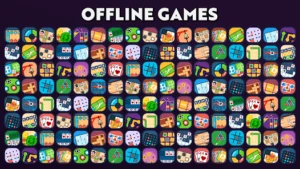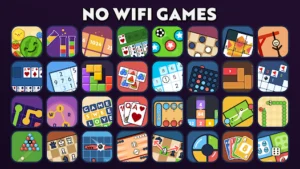Games that didn’t require internet, or offline games—no wifi games—ruled school bags, living rooms, and beds.
This decade saw the introduction of well-known games for handheld devices, PCs, and consoles that provided entertaining local multiplayer and engrossing single-player experiences.
This article highlights the major platforms, game genres, and games that shaped a generation as it examines the heyday of offline games—no wifi games.
The 2000s: A Pre-Internet Gaming Landscape
Dial-up modems and restricted broadband connectivity characterized the early 2000s. Rich, independent experiences were given top priority by developers, who created environments that let players explore uninterrupted.
Games prioritized replayability, strategic depth, and game narrative, frequently through split-screen multiplayer or large-scale campaigns.
The foundation for franchises that are still cherished today Games was established during this time.
PC Gaming: The Birth of Offline Games Legends
With genres ranging from role-playing games to real-time strategy (RTS), PCs became a hub for offline innovation:
- The Sims (2000): Will Wright’s life simulation game, which lets users create virtual lives offline, became a cultural sensation.
- Half-Life 2 (2004): Valve’s masterpiece established a standard for first-person shooter storytelling by fusing physics-based gameplay with an engrossing plot.
- Diablo II (2000): Completely offline, Blizzard’s dungeon crawler provided limitless loot-driven action
- Despite being published in the late 1990s, StarCraft: Brood War (1998) remained popular into the 2000s because of its offline skirmish mode.
- Bethesda’s open-world role-playing game, The Elder Scrolls III: Morrowind (2002), transported players to a huge, explorable continent.
These games demonstrated the adaptability of PCs by utilizing hardware innovations to provide a more immersive experience.
Mobile Gaming: The Humble Beginnings
Prior to smartphones, Snake (1997) from Nokia and simple Java games like Tetris and Space Impact were the first mobile games.
These pixelated offline games, which provided addicting enjoyment without Wi-Fi, flourished on phones with buttons.
Their ease of use and accessibility established the groundwork for the current app-dominated mobile gaming market.
Console Titans: PlayStation 2, Xbox, and GameCube
Living rooms now have access to cinematic experiences thanks to consoles:
With its storyline and split-screen multiplayer, Microsoft’s Xbox flagship game, Halo: Combat Evolved (2001), revolutionized first-person shooter gameplay.
The PS2 action-adventure game Shadow of the Colossus (2005) is renowned for its massive boss fights and simple narrative.
Handheld Gaming: Game Boy Advance and Nintendo DS
Portable gaming was transformed by the Game Boy Advance (2001) and Nintendo DS (2004). Single-player stories were the main focus of these games, which frequently included local cooperative options.
While the DS brought touchscreen innovation with Mario Kart DS (local multiplayer via Download Play) and The Legend of Zelda: The Minish Cap, the GBA brought classics like Pokémon Ruby/Sapphire and Advance Wars.
With an emphasis on portable play, wireless trading, and classic single-player adventures, both flourished offline.
Genre Deep Dive: The Offline Experience
RPGs: Journeys lasting more than 40 hours were available in games like Dragon Quest VIII (2004) and Final Fantasy X (2001).
Puzzle Games: There were several offline challenges in Bejeweled (2001) and Lumines (2004).
Prince of Persia: The Sands of Time (2003) was an action-adventure game that skillfully combined platforming with fighting.
Strategy: Careful preparation paid off in Fire Emblem (2003) and Civilization III (2001).
These genres, which prioritized player ability and story, thrived without any internet elements.
Conclusion
The 2000s gave rise to classic offline experiences, demonstrating innovation within limitations.
As the industry develops, these games offer a reminder of the delight of unplugged play, where imagination, rather than servers, creates immersion.
The games of the 2000s continue to be a beloved period in gaming history, whether you’re reliving old favorites or finding them for the first time.








